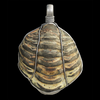Asteroids, Comets, and Meteors: A Guide to Space Rocks in the Night Sky

A piece of the Campo del Cielo meteorite. (image credit: Carlos Zito)
Post Author - Peter Bashaw
Across the solar system, there are trillions of pieces of rocky debris leftover from the formation of the sun and our planets. These space rocks have many different names that are mistakenly used interchangeably, so if you’ve ever wondered what’s a meteoroid and what’s a meteorite, or the difference between an asteroid and a comet, we'll clue you in!
Asteroids are rocky objects that make up the asteroid belt between the four inner terrestrial planets and the four outer gas giants. The difference between an asteroid and a meteoroid is a question of size, with anything smaller than one meter in diameter being a meteoroid. Asteroids on the other hand can be very large, with the largest being the dwarf planet Ceres with a diameter of 940 kilometers.
When a meteoroid falls to Earth, friction from the atmosphere produces light and heat. This is what we call a meteor. Seen at night, we might call this a shooting star, or if it’s particularly intense a fireball. Air resistance usually breaks up meteoroids as they fall, scattering their pieces across a strewn field. The material that makes it to the Earth’s surface is called a meteorite.
Comets are an entirely different kettle of fish. These space rocks have a core of material from the solar system’s formation and are surrounded by a layer of dust and ice. Unlike asteroids, they follow their own orbits around the sun. If gravitational forces draw them to the sun, the ice begins to vaporize and leak through the comet’s crust in jets. This produces a cloud of dust and ice around the comet called a coma, as well as a tail of material that can stretch across millions of kilometers.
Looking for some hands-on experience with space rocks? Lucky for you we have plenty in our Meteorite Collection...
Read More
Featured Product
Magma Ocean - Isua Greenstone Belt - 3.6 Billion Years Old
Cool Things!

Scientists Discover First Ever Ancient Roman Trilobite!
It’s well known among archaeologists that the ancient Romans had a reverence for fossils. For example, it is thought they believed mammoth bones and teeth were those of dragons and cyclopes, and thus, these items were often displayed in places of power. However, researchers in Spain recently uncovered an exceedingly rare Roman fossil artifact from an unlikely place.

Denver Museum Finds Dinosaurs in their Backyard!
For patrons of a popular Denver museum, newly discovered dinosaur fossils are quite literally in their backyard!

Neolithic Vegetarians: Learn About the Wooden Tools Used by Early Humans!
When you think of the Stone Age, scenes of Neanderthals chasing down great beasts of old for food and furs might come to mind. Many studies have shown the invention and development of stone tools were essential to early humans’ efforts to hunt animals, but according to a recent study, that perspective may have an overbearing presence in the perception of the Stone Age.
Specimen Deep Dives

The Hollywood Sign: The Story of a City's Symbol Hollywoodland

Building Disneyland

When the Sky Split in Two: The Tunguska Event
Long Form Articles

The Artist Behind the Macintosh: Susan Kare and Apple Computers
While the two Steves, Jobs and Wozniak, are the most well known faces behind Apple computers, equally important to the products and culture of the company were those who crafted the experience of using their computers through design. The most notable of these visual architects was Susan Kare, a designer responsible for “humanizing” Macintosh computers.

Can I Lick It? Yes You Can!
Have you ever been unable to tell if a fossil was really a fossil, but you were too embarrassed to admit it? Have you ever wanted to lick a fossil just because, but you didn’t want to risk judgment from your peers? Well, good news! You can kill two birds with one stone! Licking a fossil can actually help you determine if it’s the real deal or just another rock.

Is It Legal To Own a Meteorite: How to Start Your Outer Space Collection!
Meteorites are some of the rarest geological specimens to be found on Earth. Of course, since these stones are not of our world, purchasing them can sometimes be a confusing process. Is it legal to own a meteorite? In short, yes! Read on for help starting your cosmic collection!










